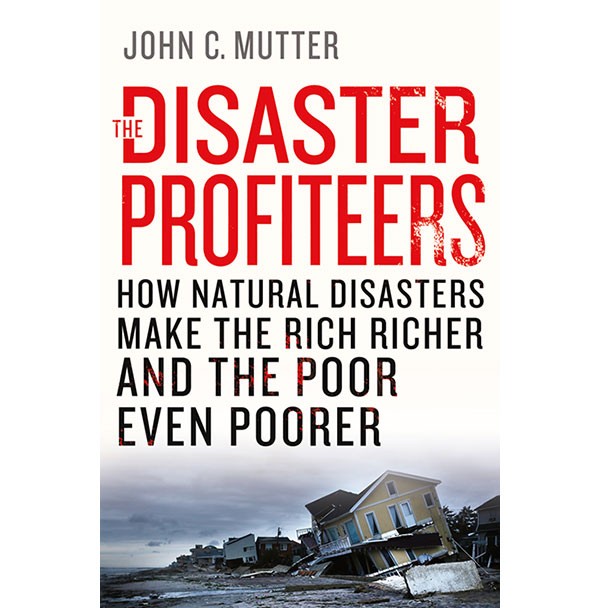
Author: John C. Mutter (St. Martin’s Press, 2015)
The Disaster Profiteers: How Natural Disasters Make the Rich Richer and the Poor Even Poorer is an analysis of what makes a natural disaster a disaster, and explores the pre-existing conditions that exacerbate extreme natural events. Mutter is a professor of Earth and Environmental Sciences and International and Public affairs at Columbia University in New York. His book arrives at some unsettling conclusions about how we have set up our societies and ties in how those decisions can impact the severity of natural disasters.
On first reading of the title, one expects that maybe this is an exposé on how relief money is potentially misspent after a disaster occurs: this is not the case. This book goes deeper and looks at the decisions that take place long before a disaster strikes that influence things like where poorer neighbourhoods are located within a community, or if there are building codes or not.
The book focuses itself by looking at how the same types of disaster affect different places. For earthquakes, it compares the 2010 8.8 magnitude Chilean earthquake with the 2010 7.0 magnitude earthquake in Haiti. For hurricanes, it compares the disasters of Hurricane Nargis in 2008 in Myanmar and Hurricane Katrina in 2005 that affected New Orleans. These examples compare events of comparable magnitude where the outcomes were different due to the social circumstances and the community structure that was in place before the disasters struck.
In comparing the Haiti quake with the Chilean, we see that there was a much higher death toll and much more infrastructure damage in Haiti. In Haiti, there has been a history of dysfunctional and corrupt government that has resulted in an appalling gap between rich and poor segments of the population. At the time of the quake, the government was so ineffectual it may as well have not existed at all. There were no building codes or enforcement to speak of, and any security forces or organizations on the ground were there to serve the most affluent first, while leaving everyone else to fend for their selves. While wealthy people could pay to have their houses constructed soundly to withstand the hurricanes that routinely affect the region, poorer people could not afford such preparations.
By comparison, Chili—while having problems of its own—had a much more government structure in place and due to its location had more experience dealing with this type of disaster. The impact of the earthquake was significant, but the population and government were able to deal with it more effectively.
With respect to the hurricanes, there were some unsettling similarities of how the events were handled in both circumstances. In Myanmar, which was being ruled by a military dictator, those in charge largely ignored and denied that there even had been a hurricane for days and weeks after it happened. In this same way, they refused to even acknowledge that there was anyone who needed help. The controlling military elites lived mainly in the newly minted capital of Naypyidaw (established 2005), and were largely unaffected by the hurricane and resulting inundation that was experienced on the coast.
On the other hand, much poorer people living in the low lying agricultural regions had their homes and livelihoods destroyed by the hurricane. Given that members of the military elite remained unaffected by the event, in their minds there was no problem, explaining the refusal to acknowledge there was even a problem for days. The lives of the people who had been affected by Hurricane Nargis did not matter to the military elite.
Hurricane Katrina saw this same delay in action by the government. The reason for the delay was again directly related to the perception of the people affected by the disaster held by those in power. In this case, the poorer, mostly African American, community was in some ways blamed for the horrible situation on the ground. The long history of racism and segregation had pushed impoverished African Americans to neighbourhoods that were more at risk to flooding and disaster. So when the hurricane hit, it was those communities that were disproportionately affected. The inherent media bias towards this group also tried to argue to some degree that maybe these people were not worth helping. At the time, directly after the hurricane, a white man taking from a grocery store was framed as “survival provisioning”; while a black man doing the same would have been reported simply as looting.
Overall, The Disaster Profiteers is an intense look at how existing social stratification can exacerbate problems during a natural disaster. Mutter argues that a hurricane or an earthquake is not simply a hurricane or an earthquake; it is a series of cascading decisions that set up how well a community is able to face extreme natural events, as a whole. Systematic oppression and vast social inequality set up communities for disaster. Preparing for disasters is not as simple as assembling your emergency kit. It is a societal and governmental choice to ensures that the entire system is braced for impact and ready to respond. Setting up the right institutions to educate, mitigate, study and prepare for extreme natural events can be the difference between a hurricane and just another storm.
***
For more information on The Disaster Profiteer, visit the website.
**
Andrew Cuthbert works as a planner and has a love for everything to do with spatial data. When not working Andrew can most likely be found on his bike taking in the sights and fresh air.




One comment
You can have a look, borrow or download this book with a Toronto Public Library Card:
http://www.torontopubliclibrary.ca/detail.jsp?Entt=RDM3284936&R=3284936